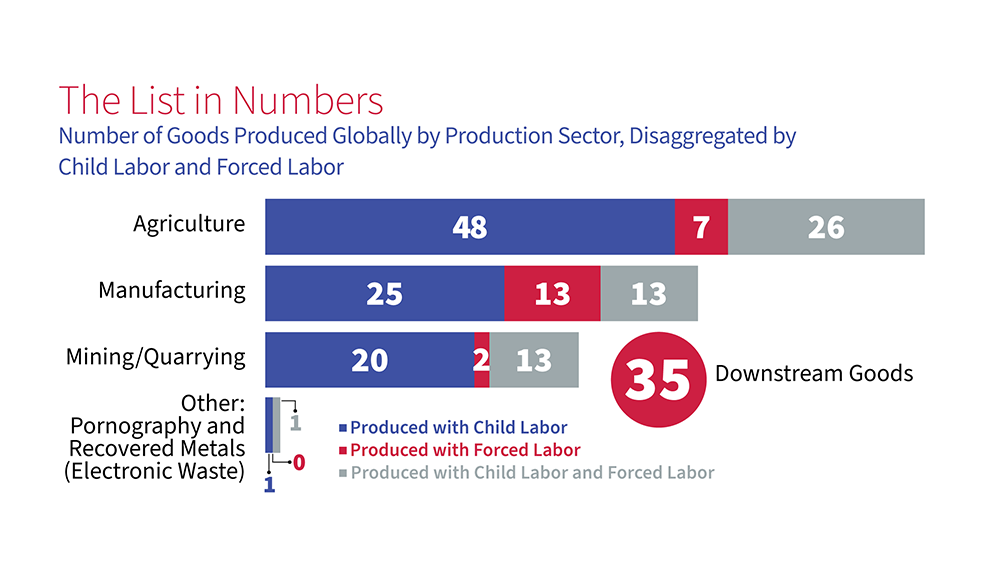List of Goods Produced by Child Labor or Forced Labor
The Bureau of International Labor Affairs (ILAB) maintains a list of goods and their source countries which it has reason to believe are produced by child labor or forced labor in violation of international standards, as required under the Trafficking Victims Protection Reauthorization Act (TVPRA) of 2005 and subsequent reauthorizations. The List of Goods Produced by Child Labor or Forced Labor comprises 204 goods from 82 countries and areas, as of September 5, 2024.
The Frederick Douglass Trafficking Victims Prevention and Protection Reauthorization Act of 2018 directs that the List include, "to the extent practicable, goods that are produced with inputs that are produced with forced labor or child labor."
ILAB maintains the List primarily to raise public awareness about forced labor and child labor around the world and to promote efforts to combat them; it is not intended to be punitive, but rather to serve as a catalyst for more strategic and focused coordination and collaboration among those working to address these problems.
Previous TVPRA List of Goods Produced by Child Labor or Forced Labor
2022
- List of Goods (Full Report) (PDF)
- List of Downstream Goods (Excel)
- List of Goods (Bibliography) (PDF)
Publication of the List has resulted in new opportunities for ILAB to engage with foreign governments to combat forced labor and child labor. It is also a valuable resource for researchers, advocacy organizations and companies wishing to carry out risk assessments and engage in due diligence on labor rights in their supply chains.
The countries on the List span every region of the world. The most common agricultural goods listed are sugarcane, cotton, coffee, tobacco, cattle, rice, and fish. In the manufacturing sector, bricks, garments, textiles, footwear, carpets, and fireworks appear most frequently. In mined or quarried goods, gold, coal and diamonds are most common.
ILAB published the initial TVPRA List in 2009 and updated it annually through 2014, following a set of procedural guidelines that were the product of an intensive public consultation process. ILAB now updates and publishes the List every other year, pursuant to changes in the law.
Procedural Guidelines
On January 25, 2024, ILAB's Office of Child Labor, Forced Labor, and Human Trafficking published Procedural Guidelines for the development and maintenance of the List of Goods from countries produced by child labor or forced labor in violation of international standards.
DOL's mission is to foster, promote, and develop the welfare of the wage earners, job seekers, and retirees of the United States. This DOL mission is carried out by a variety of sub-agencies and offices (DOL agencies) covering domestic and international policy engagements, workforce development, enforcement, statistics, and benefits. DOL has a responsibility to protect the integrity of scientific information that is produced, communicated, and used across DOL agencies to better carry out its mission. ILAB is committed to using the highest possible scientific integrity and quality standards and practices to conduct our critical work. Scientific integrity is the adherence to professional practices, ethical behavior, and the principles of honesty and objectivity when conducting, managing, using the results of, and communicating about science and scientific activities. Inclusivity, transparency, and protection from inappropriate influence are hallmarks of scientific integrity.
| Country/Area | Good | Exploitation Type |
|---|---|---|
| Nicaragua | Child Labor | |
| Niger | Child Labor | |
| Nigeria | There are reports that children as young as age 8 mine gold in Nigeria. This practice is especially common in Zamfara state, which has significant gold deposits. Media outlets report hundreds of children work in artisanal and small-scale gold mining (ASGM) throughout Nigeria, causing them to abandon school. ASGM involves physically demanding work due to the un-mechanized nature and often many occupational safety and health risks. Children use their bare hands and tools to dig for gold in tunnels hundreds of meters below ground, without any protective equipment. Children face additional health risks during the processing stage when they handle mercury, a highly toxic substance, using it to extract gold from ore. Crushing ore to extract gold exposes children to lead-contaminated dust. This exposure can lead to acute lead poisoning and in May 2015 the Government announced the deaths of 28 children from lead poisoning as a result of the illegal mining of gold in Nigeria. |
Child Labor |
| Peru | Child Labor, Forced Labor | |
| Philippines | Child Labor | |
| Senegal | Child Labor | |
| Sudan | Child Labor | |
| Suriname | Child Labor | |
| Tanzania | Child Labor | |
| Uganda | There are reports that children as young as age 7 mine gold in Uganda. This practice is especially common in eastern Uganda and in the northeastern Karamoja region, where children typically work alongside family members. According to international organizations and the media, thousands of children abandon school to work in ASGM. One research study found approximately 1,000 children working in gold mines in central Uganda. Boys work in dangerous conditions in the mines, collecting soil from deep, open pits. Children mine gold in riverbeds, use toxic mercury to process gold ore, and carry water from long distances to sift and wash sediment. |
Child Labor |
your hand? Download ILAB's Sweat & Toil App today!
Are you a company looking to fight child labor and forced labor in supply
chains?


